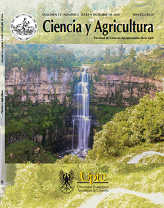Horse´s gait motion analysis system based on videometry

Abstract
In this work, we describe the development and use of a new motion analysis system to investigate and evaluate 2D kinematic of the equine gait. This system uses a motion capture software, mathematical calculations, and a graphic interface designed to evaluate locomotor patterns of the horses. From video sequences of equine motion recorded by high-speed cameras, we obtained the coordinates (x, y) using TEMA 3.0 software; then, we calculated kinematic variables such as length of body segments, joint’s angles, trajectories of each marker, and joint flexion-extension curves; and with a graphical interface developed in the Mathematica software, we generated a 2D simulation of the horses movement. This tool aims at helping to investigate and evaluate the equine gait, and analyze it in an objective way (qualitative and quantitative); However, it can be used in different fields of gait analysis. This tool removes the subjectivity of the diagnosis made by veterinarians, and allows to perform different analyses, evaluations, researches, and monitoring of the equine gait.
Keywords
equine motion, gait cycle, kinematic, motion analysis, videometry.
References
- (1) Clayton H. M. and Back Willem. Measurement Techniques for Gait Analysis. Equine Locomotion. 1a ed. W.B. Saunders; 2001. p. 40-97. ISBN: 070202483X.
- (2) Wang L, Hu W, Tan T. Recent developments in human motion analysis. Pattern Recognition; 2003; 36: 585–601. DOI: http://dx.doi.org/10.1016/S0031-3203(02)00100-0. DOI: https://doi.org/10.1016/S0031-3203(02)00100-0
- (3) Barrey E. Methods, Applications and Limitations of Gait Analysis in Horses. The Veterinary Journal; 1999; 157: 7-22. DOI: http://dx.doi.org/10.1053/tvjl.1998.0297. DOI: https://doi.org/10.1053/tvjl.1998.0297
- (4) O’Connor CM, Thorpe SK, O’Malley MJ, Vaughan CL. Automatic detection of gaits events using kinematic data. Gait Posture; 2007; 25: 469–474. DOI: http://dx.doi.org/10.1016/j.gaitpost.2006.05.016. DOI: https://doi.org/10.1016/j.gaitpost.2006.05.016
- (5) Patterson-Kane JC, Firth EC. The pathobiology of exercise-induced superficial digital flexor tendon injury in Thoroughbred horse. The Veterinary Journal; 2009; 181 (2):79-89. DOI: http://dx.doi.org/10.1016/j.tvjl.2008.02.009. DOI: https://doi.org/10.1016/j.tvjl.2008.02.009
- (6) Richards JG. The Measurement of Human Motion: A Comparison of Commercially Available Systems. Hum. Mov. Sci.; 1999; 18: 589–602. DOI: http://dx.doi.org/10.1016/S0167-9457(99)00023-8. DOI: https://doi.org/10.1016/S0167-9457(99)00023-8
- (7) Pinto F, Buaes A, Francio D, Binotto A, Santos P. Bratrack: a low-cost marker-based optical stereo tracking system, in ACM SIGGRAPH 2008. New York, NY, USA: ACM, 2008. DOI: http://dx.doi.org/10.1145/1400885.1401026. DOI: https://doi.org/10.1145/1400885.1401026
- (8) Vicon Motion Systems, “Motion Capture Systems from Vicon,” 2011; [access: June 13, 2016]. URL: http://www.vicon.com.
- (9) PhaseSpace Inc., “Optical Motion Capture”, 2016 [access: May 4, 2016]. URL: http://www.phasespace.com.
- (10) Bell RP, Reed SK, Schoonover MJ, Whitfield CT, Yonezawa Y, Maki H, Pai PF, Keegan KG. Associations of force plate and body-mounted inertial sensor measurements for identification of hind limb lameness in horses. Am J Vet Res.; 2016; 77(4): 337-345. DOI: http://dx.doi.org/10.2460/ajvr.77.4.337. DOI: https://doi.org/10.2460/ajvr.77.4.337
- (11) Castro JL, Medina-Carnicer R, Galisteo AM. Design and evaluation of a new three-dimensional motion capture system based on video. Gait & Posture; 2006; 24:126–129. DOI: http://dx.doi.org/10.1016/j.gaitpost.2005.08.001. DOI: https://doi.org/10.1016/j.gaitpost.2005.08.001
- (12) P. J. Figureueroa. “Dvideow,” 2009. Available: http://www.ic.unicamp.br/ pascual/dvideow.html.
- (13) Denham SF. Changes in conformation and walk kinematics of suckling and weanling warmblood foals. Thesis of Master of Science in Animal and Poultry Sciences. Faculty of the Virginia Polytechnic Institute and State University. 2007.
- (14) Raskar R, Nii H, Decker B, Hashimoto Y, Summet J, Moore D, Zhao Y, Westhues J, Dietz P, Barnwell J, Nayar S, Inami M, Bekaert P, Noland M, Branzoi V, Bruns E. Prakash: lighting aware motion capture using photosensing markers and multiplexed illuminators. ACM Transactions on Graphics; 2007; 26 (3): 24-36. DOI: http://dx.doi.org/10.1145/1276377.1276422. DOI: https://doi.org/10.1145/1276377.1276422
- (15) Griffin T, Main R, Farley C. Biomechanics of quadrupedal walking: how do four-legged animals achieve inverted pendulum-like movements?. Journal of Experimental Biology 2004 207: 3545-3558. DOI: http://dx.doi.org/10.1242/jeb.01177. DOI: https://doi.org/10.1242/jeb.01177
- (16) Miró F, Santos R, Garrido-Castro JL, Galisteo AM, Medina-Carnicer R. 2D versus 3D in the kinematic analysis of the horse at the trot. Vet Res Commun.2009; 33:507. DOI: http://dx.doi.org/10.1007/s11259-008-9196-x. DOI: https://doi.org/10.1007/s11259-008-9196-x
- (17) Clayton HM. 3D kinematics of the equine metacarpophalangeal joint at walk and trot. Vet. Comp. Otrhop. Traumatol: 2007; 2: 86-91. DOI: http://dx.doi.org/10.1160/vcot-07-01-0011. DOI: https://doi.org/10.1160/VCOT-07-01-0011
- (18) Dallap BL, Ryan CT, Boston RC, Nunamaker DM. The horse-racetrack interface: a preliminary study on the effect of shoeing on impact trauma using a novel wireless data acquisition system. Equine Veterinary Journal; 2010; 38(7): 664-670. DOI: https://doi.org/10.2746/042516406X156389
- (19) Qualisys Motion Capture System - Equine Kinematics. [Access: Jun 22, 2016] URL: http://www.qualisys.com/applications/biomechanics/equine/.
- (20) Lin Xie BS, Sandra O, Robinson BS, Spencer N, Randall M Jr, Gaschen L. Kinematic technique for evaluation of athletic conditioning effects on equine degenerative suspensory ligament desmitis (Codamotion, Charnwood Dynamics Ltd. Leicestershire, UK). Motion Times 2008; 2: 5. Available in: http://www.analisedemarcha.com/papers/motion_times/motiontimes2008_2.pdf.
- (21) García-Neder A, Pérez A, Perrone G. Assessment of body weight of the Criollo horse using morphometric measurements: confirmation of published equations for other breeds and development of a new formula. REDVET. Revista electrónica de Veterinaria. 2009; 10 (9): 90-96.
- (22) Valera M, Galisteo AM, Molina A, Miró F, Gómez MD, Cano MR, Agüera E. Genetic parameters of biokinematic variables of the trot in Spanish Purebred horses under experimental treadmill conditions. The Veterinary Journal; 2008; 178 (2): 219-226. DOI:http://dx.doi.org/10.1016/j.tvjl.2007.07.031. DOI: https://doi.org/10.1016/j.tvjl.2007.07.031
- (23) Torres-Pérez Y, Cuenca F, Ortiz A. 2D Articular Kinematic of a Horse During Normal Gait. Rights Reserved ©, SOMIM: 2011; 948-956.
- (24) Galisteo AM, Garrido-Castro JL, Miró F, Plaza C, Medina-Carnicer R. Assessment of a method to determine the stride phases in trotting horses from video sequences under field conditions. Wien. Tierärztl. Mschr – Vet. Med. Austria. 2010: 65-73.